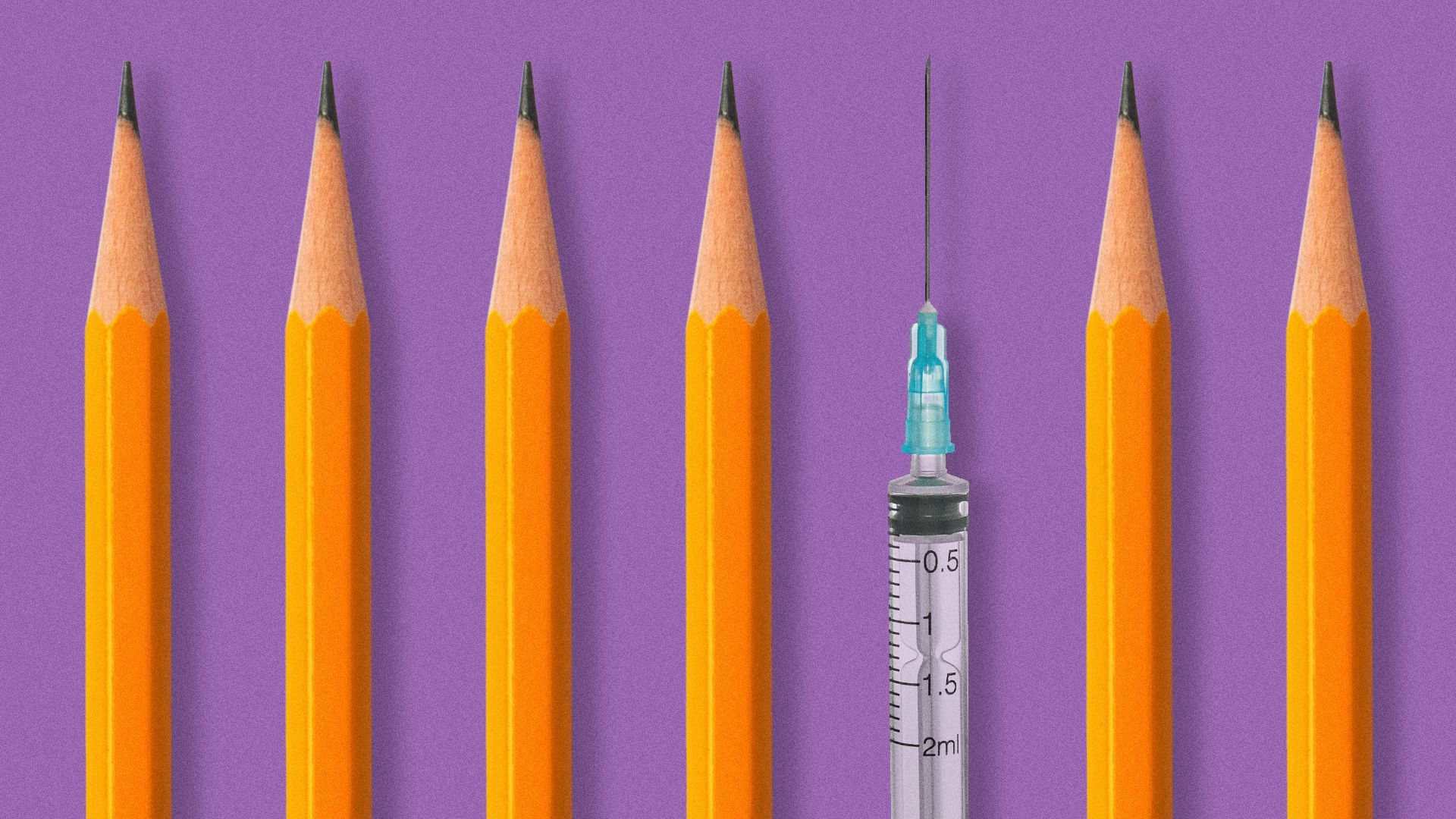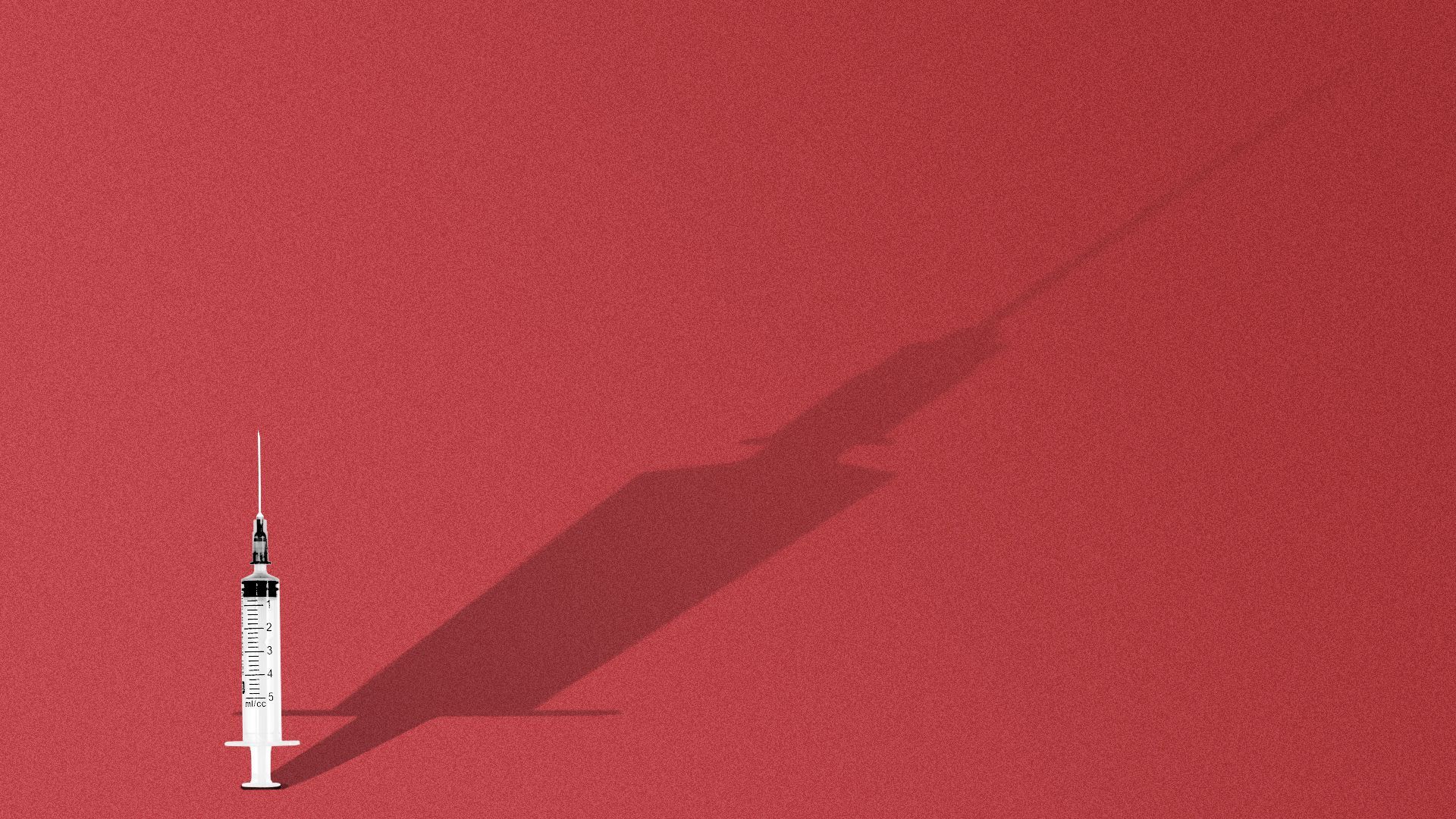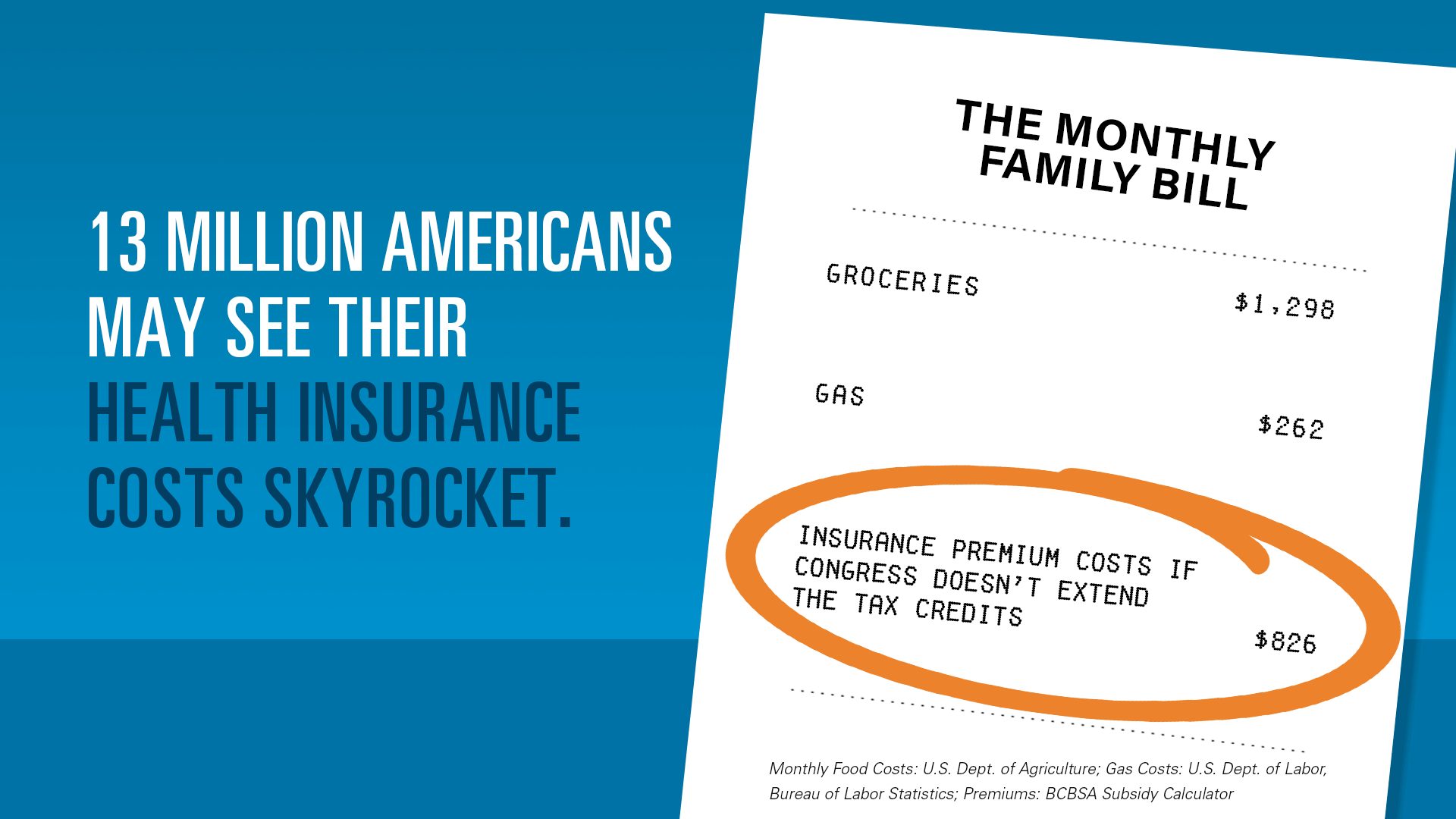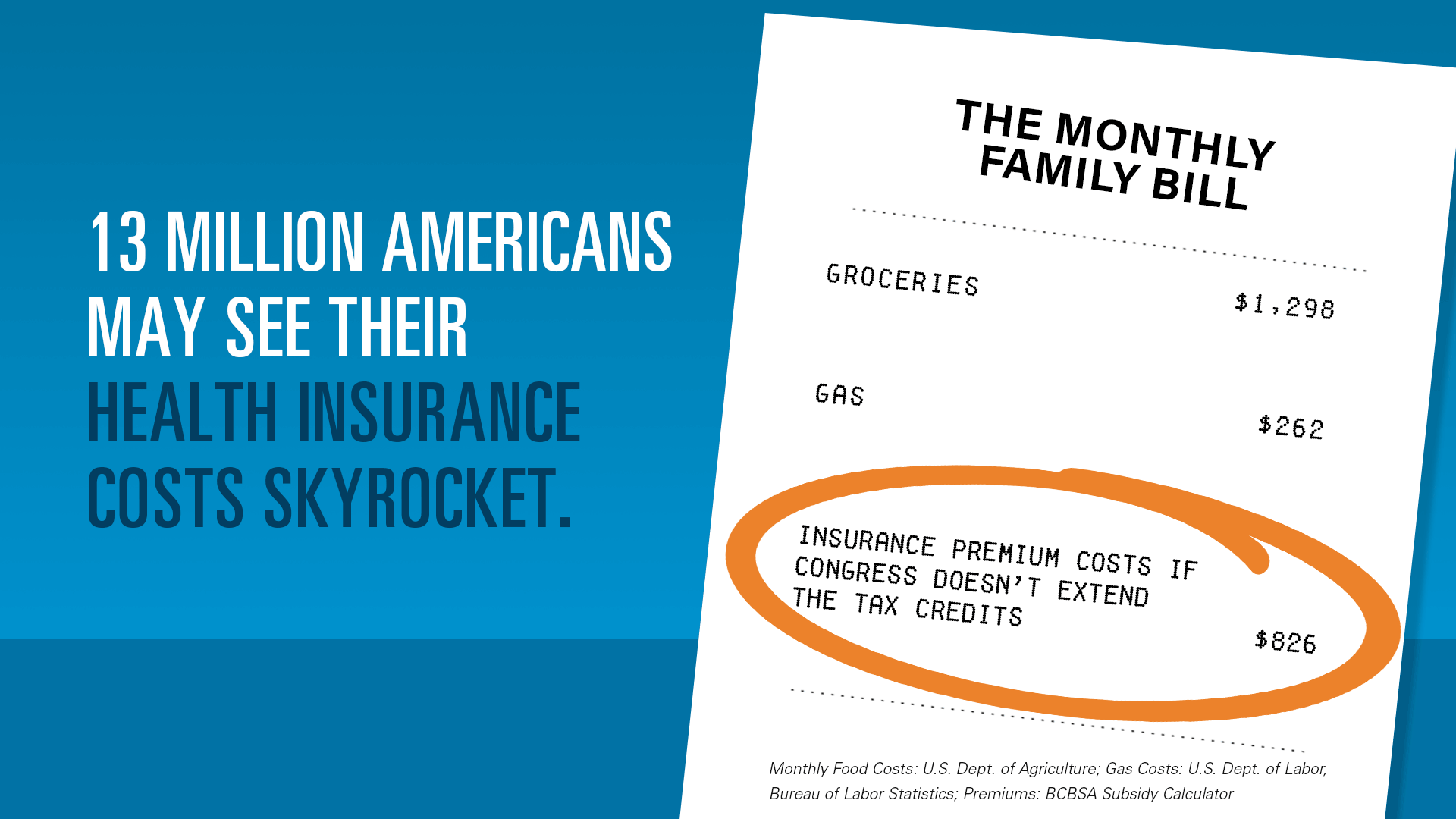| | | | | | | Presented By Blue Cross Blue Shield Association | | | | Axios Vitals | | By Tina Reed · Aug 02, 2022 | | Hello, Vitals readers! I'm back from vacation where I'm happy to say, I listened to the advice from our friends at Axios Finish Line and totally unplugged for the week. Now, for the news: The Biden administration on Monday approved a 4.3% net pay bump for Medicare inpatient hospital services in 2023, higher than the 3.2% proposal it issued in April, Axios' Adriel Bettelheim writes. - The final rule covers acute care hospitals and reflects a higher inflation forecast using more recent data, per Evercore ISI.
Today's newsletter is 929 words or a 3-minute read. | | | | | | 1 big thing: Back-to-school outbreaks |  | | | Illustration: Maura Losch/Axios | | | | As students around the country start a new school year, providers say childhood immunization rates are too low in some places to prevent outbreaks of diseases such as measles, Axios' Arielle Dreher writes. Why it matters: Schools and public health officials have to convince parents to get their kids caught up on recommended childhood vaccinations or risk the return of illnesses once mostly eliminated. - While COVID showed how outbreaks can engulf school-aged children, the pandemic response revealed the drawbacks of school closures to kids' development, making future mitigation efforts the target of likely political blowback.
What we're hearing: Global vaccination rates plummeted during the pandemic and have yet to rebound, leaving more kids and teens vulnerable. Driving the news: We've already seen out-of-season outbreaks that experts say could have been prevented through regular vaccination. - Worldwide measles cases increased 79% for the first two months of 2022 compared to 2021.
- New York health officials confirmed the first case of polio in the United States in almost a decade, in Rockland County, where the current polio vaccination rate among 2-year-olds is 60.5%, compared to a statewide average of 79.1%, per the New York health department.
- In March, a Los Angeles school banquet triggered a flu outbreak so severe that 41% of attendees reported symptoms, and administrators closed the school for in-person attendance.
Reality check: Politics is fanning anti-vaccine sentiment in the U.S. and around the world, writes Peter Hotez, a vaccine researcher at the Baylor College of Medicine, in Nature. - Administrators overseeing routine non-COVID childhood immunizations now will have to overcome more vaccine hesitancy and contend with state laws that allow parents to claim exemptions on religious and moral grounds.
Bottom line: "There are multiple reasons to vaccinate; it's not just preventing death but also allowing kids to stay in school and thrive and be social and all those things that are vital to a child's development," Gretchen LaSalle, a family physician and American Academy of Family Physicians Vaccine Science Fellow, told Axios. |     | | | | | | 2. Monkeypox vaccine falls short across U.S. |  | | | Illustration: Brendan Lynch/Axios | | | | In some hot spots for the monkeypox outbreak, there's a drastic disconnect between the number of doses that local health officials say they need versus what they have been allotted, an Axios Local review of a dozen states found. Why it matters: Across the nation, health officials worry that the outbreak could become the country's second major public health disaster in as many years if we don't work faster to contain it. What they're saying: "It is something that we could contain, but it's gonna require a great deal of effort. I believe we're behind," says Georges Benjamin, who leads the American Public Health Association. Context: There are more than 5,000 known monkeypox cases in the U.S. and no deaths, per the CDC. What's happening: States' access to vaccines is limited because the federal government is only able to purchase doses from one company in Denmark. - Some jurisdictions, including D.C., Houston and Chicago, have maxed out their shares, according to a Kaiser Family Foundation report.
- Others, including Georgia, Arkansas and Montana, have requested less than 50% of their share.
Go deeper. |     | | | | | | 3. Where out-of-pocket spending is highest |  Data: Johnson, et al., 2022, "Varied Health Spending Growth Across US States Was Associated With Incomes, Price Levels, And Medicaid Expansion, 2000–19"; Map: Axios Visuals More than four of every 10 health care dollars spent in Alaska comes from patients' pockets, according to a study published in Health Affairs. Why it matters: The study, which looked at spending variation across the U.S., found that per-person spending from state to state ranged from $7,250 to $14,500. - "These disparate trajectories are the consequence of state-specific factors that affect the demand for care, including demographics and the underlying health of the population, as well as differences in how health services are provided, financed, and regulated in each state," the authors wrote.
- They also pointed to such factors as personal income, the share of the population enrolled in Medicare or Medicaid, and health care provider supply.
By the numbers: In Alaska where per-person spending in 2019 was highest in the U.S. at $14,500, the greatest amount of spending was out of pocket (42%). Spending from private payers was about 31%, Medicaid was 18% and Medicare was 9%. - In comparison, health care spending was second highest for residents in D.C., at $14,080. But, that money was most likely to come from private payers (49%), Medicaid (26%) or Medicare (13%), compared to only 12% of spending that was out of patients' pockets.
|     | | | | | | A message from Blue Cross Blue Shield Association | | Insurance premium costs could double without critical tax credits | | |  | | | | A new analysis shows premium costs could rise to more than $800 a month for the average American family, or even more for some low-income families if Congress does not extend Affordable Care Act tax credits. The solution: Congress must finish the fight for affordable care. Find out more. | | | | | | 4. Poll: Abortion could be key issue in midterms |  Data: KFF; Chart: Nicki Camberg/Axios A majority of voters (55%) say abortion is a "very important" issue to consider when deciding how they will vote in November's midterms, up from 46% in February, Axios' Oriana Gonzalez writes about a new poll from the Kaiser Family Foundation. The big picture: While abortion is a motivating issue for some voter groups, it's eclipsed by inflation, including rising gas prices, which 74% of respondents say is "very important." Yes, but: "Lower-turnout midterm elections can be a game of inches, and abortion could make a difference, especially if gas prices continue to fall," KFF President Drew Altman said. - "It's motivating a lot of younger women to vote, and most Democrats, half of independents and even some Republicans plan to vote for candidates who support abortion access."
Read the rest. |     | | | | | | 5. Catch up quick | | 🫀 The technology behind making sure patients in the U.S. get organ transplants is out-of-date and failed "repeatedly," a confidential government report found. (Washington Post) 🧠 ICYMI: "Last Week Tonight's" John Oliver took on the massive problems with America's mental health care system and the problem with tech companies filling that gap. (YouTube) 👉 The White House named Robert J. Fenton Jr. as coordinator of the nation's monkeypox response. (Washington Post) |     | | | | | | A message from Blue Cross Blue Shield Association | | Families may face 20% higher premium costs if Congress fails to act | | |  | | | | Nearly 13 million Americans currently receive a tax credit that helps lower their premiums. What you need to know: Unless Congress extends premium tax credits, some families could see their monthly health insurance bill increase by 21% — or by up to more than $800. Congress: Finish the fight. | | |  | | Why stop here? Let's go Pro. | | | | | | Axios thanks our partners for supporting our newsletters. If you're interested in advertising, learn more here.
Sponsorship has no influence on editorial content. Axios, 3100 Clarendon Blvd, Arlington VA 22201 | | | You received this email because you signed up for newsletters from Axios.
Change your preferences or unsubscribe here. | | | Was this email forwarded to you?
Sign up now to get Axios in your inbox. | | | | Follow Axios on social media:    | | | | | |
No comments